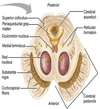Pathophysiology and Management of Raised Intracranial Pressure Flashcards
(29 cards)
What is the normal ICP?
7-20 cmH2O
(5 - 15 mmHg)
What is autoregulation in the brian?
the maintainance of adequate blood flow to the brain thorough vasoconstriction and vasodilation of small arterioes
What is chemoregulation in the brain, and therefore what would be the effect of breath holding?
altering blood flow in response to pH/CO2 levels
breath holding > elevates CO2 (dropping pH) > vasodilation to increase blood flow
If a patient were to develop an intracranial mass, how would the volume contribution of each of the components of the cranial cavity change?
reduce venous blood volume
reduce CSF volume

How can decreased blood flow in the brain lead to cerebral oedema?
decreased blood flow > neuronal cell hypoxia > failure of Na+/K+ATPase > intracelular Na+ rises > water moves into cells > neuronal swelling > further compression of blood vessels and increase in ICP > decreased blood flow cycle continues

Why do patients report an increase in headache due to raised ICP first thing in the morning?
intracranial venous pressure is increased when lying flat (normally around -10mmHg when standing)
hypoventilation during sleep > elevated CO2 > cerebral arteriole vasodilation > increased blood flow > increaed pressure
Why does coughing, bending and sneezing increase headaches due to raised ICP?
increase in thoracic pressure causes SVC inflow obstruction, limiting venous drainage from head
What may be seen on fundoscopy if a rise in ICP has been very sudden?
Retinal Haemorrhages

Why may a patient with raised ICP present with vision loss?
compression of the optic nerve
(surrounded by dura mater)
What is belived to cause vomiting in patinet with raised ICP?
hypoxia stimulates the vomiting centre in the brainstem
How may a slowly increasing ICP manifest in an infant?
increasing head circumference size

Summary of raised ICP

Summary of raised ICP

Why may a CN6 palsy present as a false lateralising lesion in a patinets with riased ICP?
CN6 origniates from posterior pons
runs ventrally over petrous part of temporal bone
raised ICP can compress CN6 against cranial floor
riased ICP may be due to a mass anywhere in cranial value but CN6 palsy would suggest it was around that region

What is a subfalcine herniation and why may some patinets present with contralateral leg weakness, whereas others could be asymptomatic?
herniation of the cingulate gyrus under the falx cerebri
hernation can lead to compression of anterior cerebral artery > supplies medial aspect of pre-central gyrus (primary motor cortex) with humuncular correlation to the lower limb

What are the possible effects of uncal herniation over the tentorium cereblli?

ipsilateral occulomotor nerve palsy
(dilated pupil due to loss of parasympathetics)
compression of cerebral peduncle
(contralateral leg weakness)
decreased level of consciousness
(compression of RAS in brainstem)

What is the greatest threat to life following a tonsilar herniation?
compression of the respiratory and cardiovascular centres in the medulla

What are the three features of Cushing’s Reflex?
Hypertension
Bradycardia
(medulla ischaemia activates SNS > hypertension detected by baroreceptors and slows HR)
Bradypnoea
(± irregular)
How can the causes of rasied ICP be characterised into 4 groups?
CSF
Brain Tissue
Blood
Other

Give 3 examples of causes of raised ICP
Hydrocephalus
Intracranial Haemorrhage
Intracerebral Abscess
(CSF Outflow Obstruction)
What is the most common cause of raised ICP?
Traumatic Brain Injury

How does the osmolarity of plasma differ from the cerebrospinal fluid?
CSF is HYPEROSMOLAR compared to plasma
(143 mEq/L vs. 138mEq/L)
Outline the flow of CSF throughout the brain?
lateral ventricles > interventricular foramen > third ventricle > cerebral aqueduct > fourth ventricle > median & lateral appertures, central canal

Which artery provides the blood supply for the lateral ventricle choroid plexus?
internal carotid artery

How does the CSF get reabsorbed from the subarachnoid space?
arachnoid villi extend into the dural venous sinuses
CSF moves across villi and is reabsorbed back into the venous circulation





